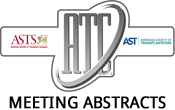2022 American Transplant Congress
Can Fibroscan Evaluation Of A Liver Predict Transplantability As Accurately As A Biopsy?
*Purpose: Liver transplants are essential procedures that can impact a patient with chronic liver disease’s overall survival. Historically liver biopsies are the gold standard in…2022 American Transplant Congress
Tissue Engineering Scaffolds for Minimally Invasive Immunosurveillance of Acute Cellular Graft Rejection
*Purpose: As there is no assay to predict the risk of acute cellular allograft rejection (ACAR), clinicians rely on protocol graft biopsy and aggressive, one-size-fits-all…2022 American Transplant Congress
Infection Impacts dd-cfDNA in Lung Transplant Recipients
*Purpose: Infection is the leading cause of death within 1 year post lung transplant. Graft injury secondary to infection is affected by both source and…2022 American Transplant Congress
Bone Mineral Density, Bone Micro-Architecture Evolution After Kidney Transplantation: A Prospective Cohort Study
*Purpose: Bone loss and mineral abnormalities are frequent in kidney transplant recipients (KTRs) and associated with a high risk of fracture and cardiovascular mortality. In…2022 American Transplant Congress
A Sign of Things to Come? Clinical Markers After Elevated Donor-Derived Cell-Free DNA in Heart Transplant Recipients
*Purpose: Endomyocardial biopsy (EMBx) has historically been the standard of care for surveillance post heart transplant (HTx), but is limited by sample area and interpretation.…2022 American Transplant Congress
Nonadherence Post-Kidney Transplant is Associated with Increased Immune Activation Detected by Peripheral Blood Gene Expression Assay
*Purpose: Nonadherence to immunosuppressive medications is common post-transplantation. We hypothesized that nonadherence results in a heightened alloimmune response in kidney transplant recipients (KTRs), which may…2021 American Transplant Congress
Donor-derived Cell-free DNA in Upper Extremity Vascular Composite Allograft Recipients
*Purpose: Diagnosing rejection in VCA recipients relies on clinical exam and biopsy which are both easily confounded by common causes of skin irritation. dd-cfDNA in…2021 American Transplant Congress
Donor-Derived Cell-Free DNA Performance Characteristics are Similar for Repeat and Primary Kidney Transplant Recipients
*Purpose: Repeat kidney transplants (RKT) represent 12.4% of kidney transplants (KT) (10.9% of all living donor and 13.6% of all deceased donor). Most RKT are…2021 American Transplant Congress
Nonadherence Post-kidney Transplant is Associated with Increased Immune Activation Detected by Peripheral Blood Gene Expression Assay
*Purpose: Nonadherence to immunosuppression medications is common post-transplantation. We hypothesize that nonadherence results in a heightened alloimmune response in kidney transplant recipients (KTRs) which in…2021 American Transplant Congress
Trugraf Gene Expression Testing Can Discriminate Rejection in the Setting of Acute Kidney Injury
*Purpose: The TruGraf kidney blood gene expression test is a well-validated non-invasive biomarker to detect immune quiescence thus ruling out silent subclinical rejection in stable…
- « Previous Page
- 1
- 2
- 3
- 4
- …
- 10
- Next Page »
